
OS TRIGONUM SYNDROME
WHAT IS IT?
Often, people do not know they have an os trigonum if it has not caused any problems. However, some people with this extra bone develop a painful condition known as os trigonum syndrome.
Os trigonum syndrome is usually triggered by an injury, such as an ankle sprain. The syndrome is also frequently caused by repeated downward pointing of the toes, which is common among ballet dancers, soccer players and other athletes.
For the person who has an os trigonum, pointing the toes downward can result in a “nutcracker injury.” Like an almond in a nutcracker, the os trigonum is crunched between the ankle and heel bones. As the os trigonum pulls loose, the tissue connecting it to the talus is stretched or torn and the area becomes inflamed.

SYMPTOMS
The signs and symptoms of os trigonum syndrome may include:
Deep, aching pain in the back of the ankle, occurring mostly when pushing o on the big toe (as in walking) or when pointing the toes downward
Tenderness in the area when touched
Swelling in the back of the ankle

TREATMENT
Treatment: Nonsurgical Approaches
Relief of the symptoms is often achieved through treatments that can include a combination of the following:
Rest. It is important to stay o the injured foot to let the inflammation subside.
Immobilization. A walking boot is often used to restrict ankle motion and to allow the injured tissue to heal.
Ice. Swelling is decreased by applying a bag of ice covered with a thin towel to the affected area. Do not put ice directly against the skin.
Oral medication. Nonsteroidal anti-inflammatory drugs (NSAIDs), such as ibuprofen, may be helpful in reducing the pain and inflammation.
Injections. Sometimes cortisone is injected into the area to reduce the inflammation and pain.
When Is Surgery Needed?
Most patientsʼ symptoms improve with nonsurgical treatment. However, in some patients, surgery may be required to relieve the symptoms. Surgery typically involves removal of the os trigonum, as this extra bone is not necessary for normal foot function.

WHAT ARE TREATMENTS FOR ACHILLES TENDINITIS?
Treatment approaches for Achilles tendinitis or tendonosis are selected on the basis of how long the injury has been present and the degree of damage to the tendon. In the early stage, when there is sudden (acute) inflammation, one or more of the following options may be recommended:
- Immobilization. Immobilization may involve the use of a cast or removable walking boot to reduce forces through the Achilles tendon and promote healing.
- Ice. To reduce swelling due to inflammation, apply a bag of ice over a thin towel to the affected area for 20 minutes of each waking hour. Do not put ice directly against the skin.
- Oral medications. Nonsteroidal anti-inflammatory drugs (NSAIDs), such as ibuprofen, may be helpful in reducing the pain and inflammation in the early stage of the condition.
- Orthotics. For those with overpronation or gait abnormalities, custom orthotic devices may be prescribed.
- Night splints. Night splints help to maintain a stretch in the Achilles tendon during sleep.
- Physical therapy. Physical therapy may include strengthening exercises, soft-tissue massage/mobilization, gait and running re-education, stretching and ultrasound therapy.

WHY CHOOSE A FOOT AND ANKLE SURGEON?
Foot and ankle surgeons are the leading experts in foot and ankle care today. As doctors of podiatric medicine – also known as podiatrists, DPMs or occasionally “foot and ankle doctors” – they are the board-certified surgical specialists of the podiatric profession. Foot and ankle surgeons have more education and training specific to the foot and ankle than any other healthcare provider.
Foot and ankle surgeons treat all conditions affecting the foot and ankle, from the simple to the complex, in patients of all ages including Haglund's deformity. Their intensive education and training qualify foot and ankle surgeons to perform a wide range of surgeries, including any surgery that may be indicated for Haglund's deformity.

